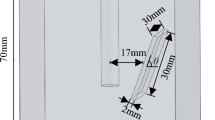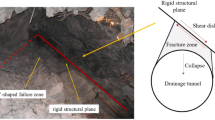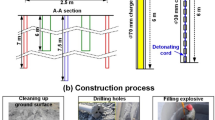Abstract
The effect law of deformation and failure of a jointed rock mass is essential for underground engineering safety and stability evaluation. In order to study the evolution mechanism and precursory characteristics of instability and failure of jointed rock masses, uniaxial compression and acoustic emission (AE) tests are conducted on sandstones with different joint dip angles. To simulate the mechanical behavior of the rock, a jointed rock mass damage constitutive model with AE characteristic parameters is created based on damage mechanics theory and taking into account the effect of rock mass structure and load coupling. To quantify the mechanism of rock instability, a cusp catastrophe model with AE characteristic parameters is created based on catastrophe theory. The results indicate that when the joint dip angle increases from 0° to 90°, the failure mechanism of sandstone shifts from tensile to shear, with 45° being the critical failure mode. Sandstone's compressive strength reduces initially and subsequently increases, resulting in a U-shaped distribution. The developed damage constitutive model's theoretical curve closely matches the test curve, indicating that the model can reasonably describe the damage evolution of sandstone. The cusp catastrophe model has a high forecast accuracy, and when combined with the damage constitutive model, the prediction accuracy can be increased further. The research results can provide theoretical guidance for the safety and stability evaluation of underground engineering.








Similar content being viewed by others
Data Availability
The datasets generated during and/or analysed during the current study are available from the corresponding author on reasonable request.
References
Bahaaddini M, Sharrock G, Hebblewhite BK (2013) Numerical investigation of the effect of joint geometrical parameters on the mechanical properties of a non-persistent jointed rock mass under uniaxial compression. Comput Geotech 49:206–225. https://doi.org/10.1016/j.compgeo.2012.10.012
Bruning T, Karakus M, Nguyen GD, Goodchild D (2019) An experimental and theoretical stress-strain-damage correlation procedure for constitutive modelling of granite. Int J Rock Mech Min 116:1–12. https://doi.org/10.1016/j.ijrmms.2019.03.003
Chen M, Jing H, Ma X, Su H, Zhu T (2017) Fracture evolution characteristics of sandstone containing double fissures and a single circular hole under uniaxial compression. Int J Min Sci Technol 27(3):499–505. https://doi.org/10.1016/j.ijmst.2017.03.027
Chen Z, Xu L, Shang Y (2021) Influence of joint angle on the acoustic emission evolution characteristics and energy dissipation rule of rock mass. Geotech Geol Eng 39(2):1621–1635. https://doi.org/10.1007/s10706-020-01581-2
Dui G, Ren Q (1999) Conjugate stress of strain E (3)= 1/3 (U3-I). Mech Res Commun 26(5):529–534
Fan X, Kulatilake PHSW, Chen X (2015) Mechanical behavior of rock-like jointed blocks with multi-non-persistent joints under uniaxial loading: a particle mechanics approach. Eng Geol 190:17–32. https://doi.org/10.1016/j.enggeo.2015.02.008
Feng Z, Chen X, Fu Y, Qing S, Xie T (2021) Acoustic emission characteristics and joint nonlinear mechanical response of rock masses under uniaxial compression. Energies 14(1):200. https://doi.org/10.3390/en14010200
Fu CH, Chen SH (2008) Study on instability criteria of surrounding rock of underground engineering cavern based on catastrophe theory. Rock Soil Mech 29(1):167–172. https://doi.org/10.16285/j.rsm.2008.01.041
Guo YH, Chen Q (2017) Study on prediction of rock burst risk based on catastrophe theory. Coal Eng 49(10):115–118
He JP (2014) Research and analysis on rock acoustic emission wave characteristics. Appl Mech Mater 638:534–537
Hou ZJ, Yang BQ, Zhang L, Chen Y, Yang GX (2020) Comprehensive method to test the stability of high bedding rock slop subjected to atomized rain. Appl Sci 10(5):1577. https://doi.org/10.3390/app10051577
Huang CF, Tian SG, Wu SC, Gao YT (2016) Stability analysis of goaf roof based on catastrophe theory and generalized h-b failure criterion. J China Coal Soc 41(S2):330–337. https://doi.org/10.13225/j.cnki.jccs.2016.0834
Jin PJ, Wang EY, Liu XF, Huang N, Wang SH (2013) Catastrophe progression method on comprehensive evaluation of rock burst. J Min Saf Eng 30(2):256
Kachanov LM, Krajcinovic D (1986) Introduction to continuum damage mechanics. Springer Science & Business Media, Berlin, p 10
Kulatilake PHSW, Malama B, Wang J (2001a) Physical and particle flow modeling of jointed rock block behavior under uniaxial loading. Int J Rock Mech Min Sci 38(5):641–657. https://doi.org/10.1016/S1365-1609(01)00025-9
Kulatilake PHSW, Liang J, Gao H (2001b) Experimental and numerical simulations of jointed rock block strength under uniaxial loading. J Eng Mech 127(12):1240–1247. https://doi.org/10.1061/(ASCE)0733-9399(2001)127:12(1240)
Kulatilake PHSW, Park J, Malama B (2006) A new rock mass failure criterion for biaxial loading conditions. Geotech Geol Eng 24(4):871–888. https://doi.org/10.1007/s10706-005-7465-9
Li J, Wang L, Sun X (2014) Experimental study on anisotropic mechanical characteristics of jointed rock masses under unloading condition. Chin J Rock Mech Eng 33(5):892–900. https://doi.org/10.13722/j.cnki.jrme.2014.05.004
Liang DX, Jiang ZQ, Zhu SY, Sun Q, Qian ZW (2016) Experimental research on water inrush in tunnel construction. Nat Hazards 81(1):467–480. https://doi.org/10.1007/s11069-015-2090-2
Liu JG, Bao JS, Yin Y, Yang SG (2015a) Applications of catastrophe theory in engineering: a review. J Comput Theor Nanosci 12(12):5739–5744. https://doi.org/10.1166/jctn.2015.4710
Liu ZX, Lan M, Xiao SY, Guo HQ (2015b) Damage failure of cemented backfill and its reasonable match with rock mass. Trans Nonferrous Met Soc China 25(3):954–959. https://doi.org/10.1016/S1003-6326(15)63684-6
Liu Q, Zhao Y, Tang L, Liao J, Wang X, Tan T, Chang L, Luo S, Wang M (2022a) Mechanical characteristics of single cracked limestone in compression-shear fracture under hydro-mechanical coupling. Theor Appl Fract Mec 119:103371. https://doi.org/10.1016/j.tafmec.2022.103371
Liu J, Zhao Y, Tan T, Zhang L, Zhu S, Xu F (2022b) Evolution and modeling of mine water inflow and hazard characteristics in southern coalfields of china: a case of meitanba mine. Int J Min Sci Technol 32(3):513–524. https://doi.org/10.1016/j.ijmst.2022.04.001
Mehranpour MH, Kulatilake PH, Xingen M, He M (2018) Development of new three-dimensional rock mass strength criteria. Rock Mech 51(11):3537–3561. https://doi.org/10.1007/s00603-018-1538-6
Mou HW, He XQ, Song DZ, Li ZL, Qi LM, Su DF, Yin S (2020) Response characteristics and influence mechanism of uniaxial compression mechanics and AE of coal with different joint angles. J China Coal Soc 45(5):1726–1732. https://doi.org/10.13225/j.cnki.jccs.DY20.0240
Odintsev VN (1995) Analytical prediction of the dynamic effects of mine pressure. J Min Sci 31(4):245–255. https://doi.org/10.1007/BF02048224
Qiao C, Guo YH, Li CH (2021) Study on rock burst prediction of deep buried tunnel based on cusp catastrophe theory. Geotech Geol Eng 39(2):1101–1115. https://doi.org/10.1007/s10706-020-01547-4
Son M, Adedokun S (2016) Effect of joint inclination angles on the earth pressure against the support system in a jointed rock mass. KSCE J Civ Eng 20(4):1259–1266. https://doi.org/10.1007/s12205-015-0487-9
Sun B, Hou SS, Xie JH, Zeng S (2019) Failure prediction of two types of rocks based on acoustic emission characteristics. Adv Civ Eng 2019:1–1. https://doi.org/10.1155/2019/5028489
Tang Y, Wang P, Cheng A, Xu MG, Hu XL (2018) Study on water inrush disaster in overlying strata of stope based on cusp catastrophe theory. Min Res Dev 38(8):93–96. https://doi.org/10.13827/j.cnki.kyyk.2018.08.020
Wang J, Song WD, Fu JX (2018) A damage constitutive model and strength criterion of rock mass considering the dip angle of joints. Chin J Rock Mech Eng 37(10):2253–2263. https://doi.org/10.13722/j.cnki.jrme.2018.0496
Wasantha PLP, Ranjith PG, Zhang QB, Xu T (2015) Do joint geometrical properties influence the fracturing behaviour of jointed rock? An investigation through joint orientation. Geomech Geophys Geo-Energ Geo-Resour 1(1):3–14. https://doi.org/10.1007/s40948-015-0001-3
Wu XZ, Liu JW, Liu XX, Zhao K, Zhang Y (2015) Study on the coupled relationship between ae accumulative ring-down count and damage constitutive model of rock. J Min Saf Eng 32(1):28–34. https://doi.org/10.13545/j.cnki.jmse.2015.01.005
Wu Q, Kulatilake PHSW (2012) REV and its properties on fracture system and mechanical properties, and an orthotropic constitutive model for a jointed rock mass in a dam site in China. Comput Geotech 43:124–142. https://doi.org/10.1016/j.compgeo.2012.02.010
Xu XD, Sun GH, Yao XJ, Liang XJ, Shao LH (2020) A cusp catastrophe warning model for instability of backfill based on energy dissipation and release. Rock Soil Mech 41(9):3003–3012. https://doi.org/10.16285/j.rsm.2019.1475
Yang WJ, Xie Q, Ban YX, He XB, Peng GY (2021) The acoustic emission characteristics and damage constitutive model of sandstone under variable loading rates. Chin J Underground Space Eng 17(01):71–79
Yang RS, Wang MY, Yang Y, Wang JG (2016) Simulation material experiment on the dynamic mechanical properties of jointed rock affected by joint-filling material. J Vib Shock 35(12):125–131. https://doi.org/10.13465/j.cnki.jvs.2016.12.019
Yuan Y, Fu J, Wang X, Shang X (2020) Experimental study on mechanical properties of prefabricated single-cracked red sandstone under uniaxial compression. Adv Civ Eng. https://doi.org/10.1155/2020/8845368
Zhang Y, Zuo S, Yu B, Chen S, Jia J (2019) Study on bending damage constitutive model and mechanical properties of limestone based on acoustic emission. Adv Civ Eng. https://doi.org/10.1155/2019/2031520
Zhao Y, Zhang L, Wang W, Pu C, Wan W, Tang J (2016) Cracking and stress–strain behavior of rock-like material containing two flaws under uniaxial compression. Rock Mech Rock Eng 49(7):2665–2687. https://doi.org/10.1007/s00603-016-0932-1
Zhao Y, Zhang C, Wang Y, Lin H (2021) Shear-related roughness classification and strength model of natural rock joint based on fuzzy comprehensive evaluation. Int J Rock Mech Min 137:104550. https://doi.org/10.1016/j.ijrmms.2020.104550
Zhao Y, Zhang J, Yuan S (2014) Safety evaluation for stability of underground powerhouse surrounding rock based on catastrophe theory. Chin J Rock Mech Eng 33(S2):3973–3978. https://doi.org/10.13722/j.cnki.jrme.2014.s2.073
Zhao XC, Zhao XY, Guo JQ (2020) Experimental study on acoustic and mechanical properties of intermittent jointed rock mass. Chin J Rock Mech Eng 39(07):1408–1419. https://doi.org/10.13722/j.cnki.jrme.2020.0008
Zhou ZH, Chen ZH, Bao M, Nian QK, Zhang W (2020) Stability of rock slope with bedding intermittent joints based on catastrophe theory. J China Coal Soc 45(S1):161–172. https://doi.org/10.13225/j.cnki.jccs.2019.0958
Zhu JQ, Li TZ (2020) Catastrophe theory-based risk evaluation model for water and mud inrush and its application in karst tunnels. J Cent South Univ 27(5):1587–1598. https://doi.org/10.1007/s11771-020-4392-0
Acknowledgements
This work was supported by the Natural Science Foundation of Hunan Province, China(Grant No.2021JJ30575), and National Natural Science Foundation of China(Grant No. 51204098)
Author information
Authors and Affiliations
Contributions
The experiments were designed and performed by BS and SZ and YL. Data processing was performed by HY. The manuscript was prepared by HY. All authors reviewed the manuscript.
Corresponding author
Ethics declarations
Conflict of interest
All authors declare that they have no conflict of interest.
Additional information
Publisher's Note
Springer Nature remains neutral with regard to jurisdictional claims in published maps and institutional affiliations.
Rights and permissions
Springer Nature or its licensor holds exclusive rights to this article under a publishing agreement with the author(s) or other rightsholder(s); author self-archiving of the accepted manuscript version of this article is solely governed by the terms of such publishing agreement and applicable law.
About this article
Cite this article
Sun, B., Yang, H., Zeng, S. et al. Damage Constitutive and Failure Prediction of Artificial Single-Joint Sandstone Based on Acoustic Emission. Geotech Geol Eng 40, 5577–5591 (2022). https://doi.org/10.1007/s10706-022-02234-2
Received:
Accepted:
Published:
Issue Date:
DOI: https://doi.org/10.1007/s10706-022-02234-2




